
I've been in a porridge bread mood lately. The thing to note with porridge breads is that the water in the porridge can lead to a very wet and slack dough that can be hard to handle. Two months ago I tried to make an oat porridge bread. The dough was so wet that I wasn't able to shape it. After struggling with it I finally just scooped the dough into the brotform. After cold proofing, the dough stuck and I had to scrape it out of the form. The resulting baked loaf was very flat and very sad.
Since the failure of my oat porridge bread, I've learned a lot and I've practiced a lot too. I've learned to not rush the dough and to make sure the gluten is developed and properly fermented. Regardless of the hydration level, if the gluten isn't developed properly, I won't be able to shape the dough. I've learned to handle high(er) hydration doughs without adding too much flour. But I've also learned that if the dough feels too wet, it might be just that. Too wet. And it's okay to add more flour. It's okay to do another set of stretches and folds. It's okay let the bulk fermentation go another 30, 60 or 90 minutes. With each loaf I bake and with each week that passes, I feel my bread baking confidence grow.
I baked a couple breads with corn polenta porridge recently. I started with a lower hydration dough (70%) and added a small amount of porridge (17%). I was able to handle that dough so for the next bake I increased the hydration to 77% and the amount of porridge to 25%. The hydration including the porridge was around 89%. That bake seemed to go pretty well too and I had no issues handling that dough.
So it was time for me to tackle the oat porridge bread again. I used the Tartine basic country bread as my base recipe. I used 20% whole wheat and added 50% (baker's pct) oat porridge.
The oat porridge consisted of a 1:4 ratio of rolled oats to water which I cooked over medium heat until it was porridge-like. I let it cool while I mixed the dough. After some gluten was developed, I mixed the oat porridge into the dough. Bulk fermentation was done at room temperature (about 74F) with stretches and folds.
If my math was correct, the hydration was 102% including the oat porridge. The dough was pretty slack when I was preshaping, but I managed to loosely shape it for the bench rest.
I shape retarded in the refrigerator for 15 hours. I went a little overboard with the oatmeal flakes because I wanted to make sure the dough came out of the brotform without sticking. It did stick a little bit, but I got them both out without too much damage.
I baked them in enameled cast iron pots. 450F for 20 minutes with the lids on and 25 minutes without lids. The batard was a bit pale compared to the boule since the high sides of the oval pot seems to shield the loaf from the heat. So I left the batard in for 5 more minutes with the oven turned off.
The crumb was very moist and it wasn't dense at all. But I think it was on the verge of gummy, but toasting the bread before eating removed all trace of that. You wouldn't know that there were oats in the loaf. They seemed to have disintegrated.
I never thought that I would be able to handle a 102% hydration dough. I think I've come a long way.
:) Mary
- emkay's Blog
- Log in or register to post comments
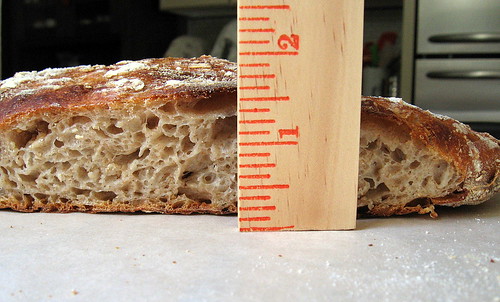
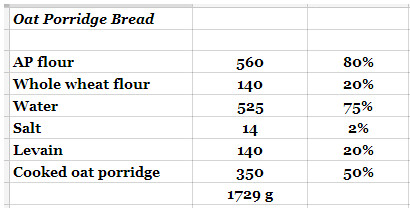

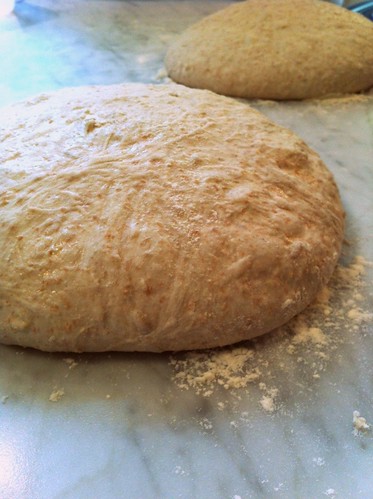
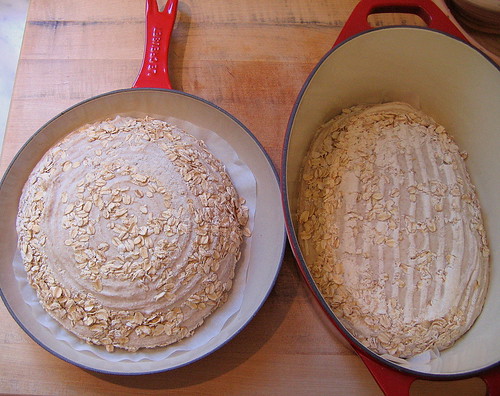
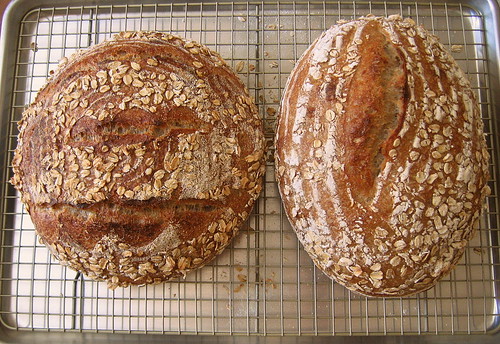
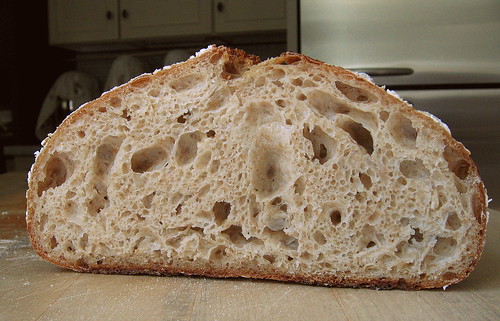
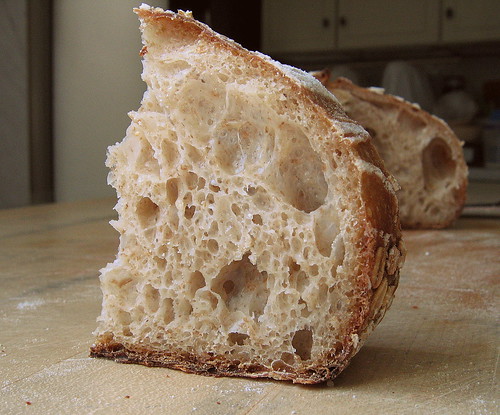


These porridge breads are a bit tricky when following the book's instructions exactly. You did a fantastic job. Crumb looks amazing. I've found the crumb to be a bit "gummy" or too moist as well and think a good 24 hour rest before slicing is in order for these breads along with a very full bake.
Nice Bake
josh
I find it very hard to wait 24 hours before slicing. :) But I will try to resist next time. Thanks Josh!
The trick is to bake enough loaves so that you can't cut them all in the first 24 hours after baking.
These look great. And I think I may throw some oats on my bread to keep them from sticking in the future. :)
If I had more brotforms (or is it brotformen?) I guess I would be able to bake more than 2 loaves at a time and then I could cut into them!
Every time I've made "porridge" breads i do the same and have to cut one. And every time I say to myself, "shoulda waited". I promised myself the last time I would let them rest at least 12 hours before slicing. I'll let you know if my old promise to myself was good enough to keep the knife in the cupboard.
Josh
My bread knife is ALWAYS out on my Boos block so it beckons me to use it.
I suppose it was a metaphor for don't cut it just yet. My bread knife goes from cutting board and gets a wash every by and by but lands right back at the cutting board. I think it might actually be afraid of the knife drawer
Josh
I'm not sure it is 102 % hydration since some of the water cooks off when making the porridge but still, bread just doesn't get much better than your example. Porridge makes the bead more moist as the liquid is released as it bakes. I tend to boldly bake these kinds of breads to 210 F - 212 F instead of 205 F to try to compensate of the moist crumb.. That instant read thermometer is a get tool. Love your bake a lot. Well Done and
Happy Baking
I'm a bit OCD, so I weighed the porridge before and after cooking to account for any water that was cooked off. I used the 'after weight' to do my hydration calculation. Either way, it was wet. Like you mentioned, a bolder bake would have been good for this loaf. I know it's silly but always feel bad poking a a thermometer into my freshly baked loaf, but I guess it needs to be done. Thanks dab!
Brilliant, Mary. An absolutely beautiful bake! I think your description of the learning curve is spot on (I can certainly relate to that first attempt!). My guess is that the “verge of gummy” feeling is the oats making their presence known – they do hold a lot of moisture and bring their own starchiness to the loaf, even if they aren’t visible anymore. That crumb looks too perfect to be gummy in the slightest for any other reason. As Josh and dabrownman mention, a full bake and a bit of rest are just the thing. Or, as you found, if you just can't wait (I never can) a little toasting is all it takes. Thanks for sharing!
Marcus
Glad to know that the slight gumminess wasn't because I did something wrong (except for not baking bolder and slicing too soon). Thanks so much, Marcus!
I'm baking my way through Tartine #3's porridge breads. They are always somewhat gummy when you cut them the first day (it's the same with higher percent rye breads). I know that, but it doesn't bother me - I eat some when it's still warm, anyway.
Your bread looks very nice, and you are right, it is a learning process with trial and error, before you get those high hydration plus porridge loaves right.
Karin
I just got my copy of Tartine No. 3, but haven't baked anything from it yet. If I ever bake a higher % rye bread, I will keep in mind that I need to let it rest before cutting. Thanks Karin!
More success with porridge, congratulations! Remember when porridge was disregarded as merely a meal for those who could not afford more? Growing up, one version or another was my favorite breakfast, and still represents true comfort food. Now it's a means to bringing more whole grains, textures and flavors to our breads. Ingenious and delicious! I'm envious of the progress you and others are making, but enough to keep me on task to making it work in my kitchen, too!
Cathy
It's funny how porridge and gruel, a means of subsistence and economy, is now de rigueur for us bread geeks. Keep practicing and you will eventually make it work for you too! Thanks Cathy!
Beautiful bake Mary! It's so nice to get at least close to the result you are looking for and these breads taste great. I already just about finished the one I baked a few days ago and may have to defrost the second one :).
Regards,
Ian
I gave my second loaf away but I wish I hadn't. Thanks for the porridge inspiration, Ian!